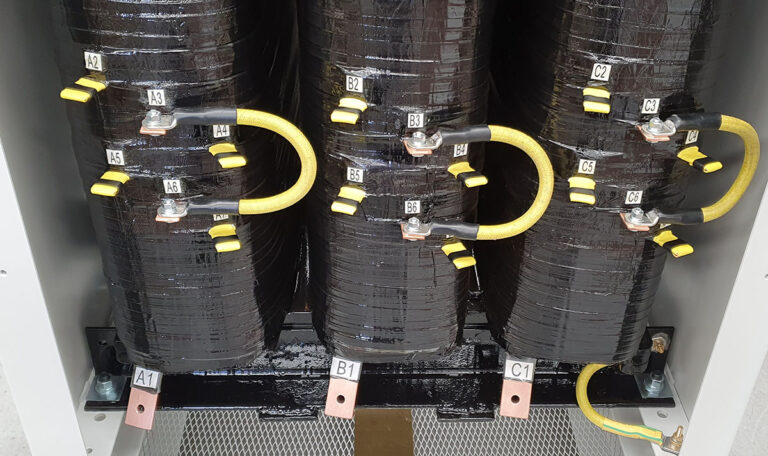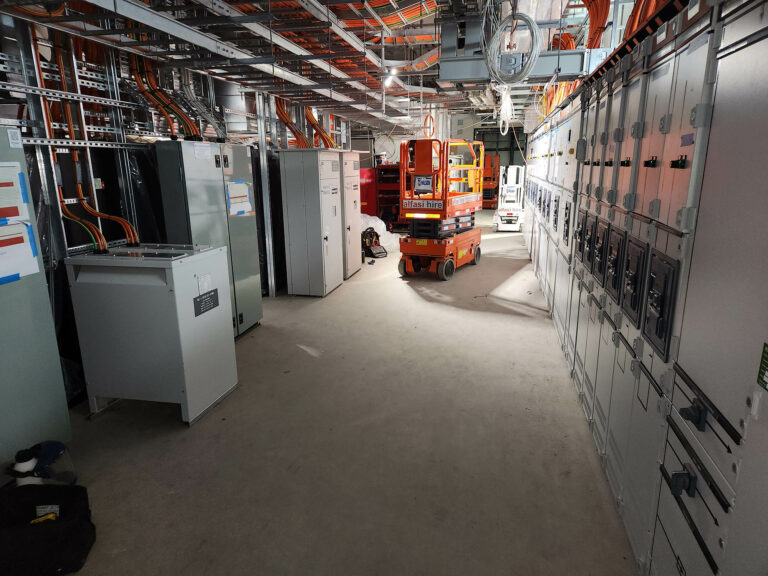Isolation transformers play a crucial role in electrical systems by providing electrical separation between the primary and secondary circuits. These transformers have gained popularity for their ability to protect sensitive equipment and personnel from electrical hazards.
However, despite their many benefits, some misconceptions and concerns linger about their safety. In this blog post, we will explore the functioning of isolation transformers, debunk common myths, and answer the question: Can you get a shock from an isolation transformer?
How Does an Isolation Transformer Work?
An isolation transformer operates on the principle of electromagnetic induction. It consists of two separate coils, namely the primary and secondary winding, wound around a common magnetic core.
The primary winding connects to the input power source, while the secondary winding delivers the isolated output power. The key feature of an isolation transformer is that there is no direct electrical connection between the two windings, ensuring complete electrical isolation.
The primary purpose of an isolation transformer is to prevent electrical noise, surges, and potentially hazardous currents from reaching sensitive electronic devices or users. They are commonly used in medical facilities, data centres, audio equipment, and various industrial applications.
Electrical Safety Measures
Before delving further into the topic, it is essential to understand the significance of electrical safety. Electric shocks can be life-threatening and cause severe injuries or even fatalities. Grounding and insulation are two fundamental concepts that aid in reducing the risk of electrical shocks.
Grounding involves providing a path for electrical currents to flow safely to the ground in the event of a fault. On the other hand, insulation is the process of enclosing conductors in non-conductive materials to prevent unintended contact with live wires. Both grounding and insulation are essential elements of electrical safety and are particularly relevant in the context of isolation transformers.
Understanding Grounding and Isolation
One common misconception is confusing grounding with isolation. Grounding provides a safe path for fault currents, while isolation prevents any direct electrical connection between two circuits.
In other words, grounding is designed to protect against faults, whereas isolation is primarily intended to eliminate electrical noise and interference.
An isolation transformer ensures that even if a fault occurs in the secondary circuit, it does not affect the primary circuit or the user handling the equipment. As a result, the potential for electrical shocks is significantly reduced.
Myths and Misconceptions
Misinformation often surrounds isolation transformers, leading to unwarranted concerns about their safety. Let’s debunk some of the common myths:
- Myth: Isolation Transformers Can Cause Shocks – This is a prevalent misunderstanding. Since isolation transformers electrically separate the primary and secondary circuits, the risk of shocks from the secondary side is eliminated when used correctly.
- Myth: Isolation Transformers are Unnecessary – Some may believe that grounding alone is sufficient to ensure safety. However, isolation transformers provide an additional layer of protection, especially in sensitive electronic applications.
- Myth: Isolation Transformers Reduce Efficiency – While there might be minor losses due to the transformer’s design, the benefits of electrical safety and equipment protection outweigh any efficiency concerns.
Can You Get a Shock from an Isolation Transformer?
The straightforward answer is: No, you cannot get a shock from an isolation transformer when it is properly designed, installed, and maintained. As explained earlier, the isolation between primary and secondary windings ensures that any fault in the secondary circuit does not pose a risk to the user or the primary circuit.
It’s essential to note that while isolation transformers minimise the risk of shocks, there could still be other electrical hazards within the system. Therefore, it is crucial to follow electrical safety protocols and use additional safety measures where necessary.
Real-Life Applications of Isolation Transformers
Isolation transformers find extensive use in various applications:
- Medical Facilities: They are utilised in medical equipment to protect patients and medical personnel from electric shocks and to maintain clear electrical signals.
- Data Centers: Data centres use isolation transformers to safeguard sensitive servers and networking equipment from power fluctuations and electrical disturbances.
- Audio Equipment: In audio setups, isolation transformers eliminate ground loops and reduce noise for high-fidelity sound output.
- Industrial Settings: Isolation transformers are employed to protect valuable machinery from electrical surges and ensure reliable operation.
Proper Handling and Maintenance
To ensure the continued safety and reliability of isolation transformers, proper handling and routine maintenance are essential. It is crucial to adhere to manufacturer guidelines and consult professionals for installation and servicing.
Regulations and Standards
Various electrical safety standards and regulations govern the design, manufacturing, and installation of isolation transformers. Compliance with these standards ensures that the transformers meet the necessary safety requirements.
Conclusion
Isolation transformers are invaluable components in electrical systems, providing crucial electrical separation between circuits and ensuring enhanced safety. It is vital to recognise their role in preventing electric shocks and protecting sensitive equipment.
When used correctly and maintained appropriately, isolation transformers pose no risk of electric shocks. Always prioritise electrical safety by adhering to best practices and consulting experts when needed.
At Southern Electronic Services, we offer customised isolation transformers that ensure electrical safety and reliable operation. Reach out to us today to learn more.
FAQs – Can You Get a Shock From an Isolation Transformer?
What is an isolation transformer?
An isolation transformer is an electrical device that consists of two separate coils wound around a common magnetic core. It provides complete electrical separation between the primary and secondary circuits, ensuring that there is no direct electrical connection between them.
How does an isolation transformer differ from a regular transformer?
Unlike a regular transformer, which provides a direct electrical connection between the primary and secondary windings, an isolation transformer offers complete isolation. This isolation prevents electrical noise, surges, and potentially hazardous currents from passing between the primary and secondary circuits.
Can you get a shock from an isolation transformer?
No, you cannot get a shock from an isolation transformer when it is properly designed, installed, and maintained. The electrical separation between the primary and secondary circuits ensures that any fault in the secondary circuit does not pose a risk to the user or the primary circuit.
Is grounding necessary when using an isolation transformer?
Yes, grounding is still essential when using an isolation transformer. Grounding provides a safe path for fault currents to flow to the ground in the event of a fault in the system. The combination of grounding and isolation enhances electrical safety in the overall electrical system.
Are isolation transformers required in all electrical applications?
Isolation transformers are not mandatory for all electrical applications. They are commonly used in specific scenarios where electrical separation is crucial to protect sensitive equipment or personnel from electrical hazards. Applications like medical facilities, data centres, and audio setups often benefit from their use.
Can isolation transformers reduce electrical efficiency?
While there may be some minor losses due to the transformer’s design, the reduction in electrical efficiency is generally negligible. The safety benefits and protection they offer to sensitive equipment and personnel far outweigh any minimal efficiency concerns.
How do isolation transformers benefit sensitive electronic equipment?
Isolation transformers protect sensitive electronic devices from electrical disturbances and voltage fluctuations. They also help eliminate ground loops and minimise electromagnetic interference, ensuring reliable and high-quality performance.
Can I use an isolation transformer as a substitute for proper grounding?
No, an isolation transformer should never be used as a substitute for proper grounding. Grounding serves a different purpose, providing a safe path for fault currents and protecting against electrical hazards. The combination of both grounding and isolation is essential for comprehensive electrical safety.
Are there any safety standards for isolation transformers?
Yes, there are safety standards and regulations that govern the design, manufacturing, and installation of isolation transformers. Compliance with these standards ensures that the transformers meet the necessary safety requirements and provide reliable performance.
How do I ensure the safety of an isolation transformer?
To ensure the safety of an isolation transformer, follow these guidelines:
- Purchase high-quality transformers from reputable manufacturers.
- Install the transformer correctly, adhering to manufacturer instructions and relevant safety standards.
- Regularly inspect and maintain the transformer to identify and address any issues promptly.
- Consult qualified professionals for installation, maintenance, and troubleshooting.
Remember, prioritising electrical safety is crucial, and using isolation transformers appropriately can significantly enhance the safety and performance of your electrical system.
Next Post
Which Transformer is Used for Solar Panels?
July 4, 2023Other News

The Role of Isolation Transformers in Data Centers
Safeguarding Data Integrity: The Role of Isolation Transformers in Data Centers In the intricate web of modern technology, data centers stand as the formidable fortresses guarding our digital world. They are the nerve centers of our interconnected society, where terabytes of information flow ceaselessly. Within these behemoths of computing power, every bit and byte is…

Microsoft Data Centers & SES transformers
Microsoft Data Centers & SES transformers Microsoft has begun its $5 billion infrastructure investment in Australia. The project encompasses building hyperscale data centres around Melbourne, Canberra and Sydney, and is designed to accomplish three main objectives: To expand its hyper-scale cloud computing and storage in Australia, and help the nation seize the artificial intelligence (AI)…



